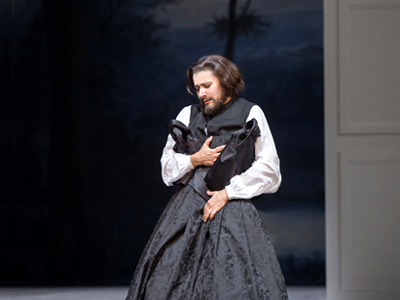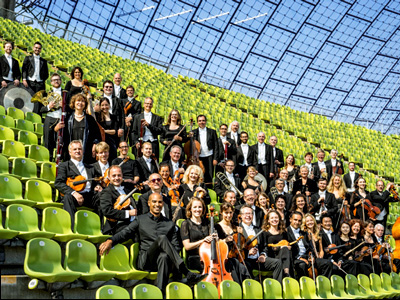by Sedgwick Clark
Alan Gilbert and the New York Philharmonic are on a European tour for a couple of weeks, and for a change I didn’t roll my eyes in despair when I saw the list of repertoire. His predecessors as music director, Kurt Masur and Lorin Maazel, for all their superb work at building the ensemble, utilized Dvořák’s “New World” Symphony (1894) as the orchestra’s calling card. But not only has Gilbert leapt ahead half a century to show off the ensemble with another Philharmonic commission conducted by its composer at its premiere, Stravinsky’s Symphony in Three Movements (1946), on February 17 he has included the U.K. premiere of Thomas Adès’s hot-off-the-press Polaris, which the Phil played in its New York City premiere only a month ago. Moreover, he has also programmed Composer in Residence Magnus Lindberg’s 1997 Féria three times.
The repertoire list below must come as a genuine jolt to anyone who has looked at how the orchestra presents itself to the world. Not even Zubin Mehta, who was not averse to contemporary music during his tenure, had the nerve to acknowledge the 20th century so thoroughly on tour. The only German chestnut here is the Beethoven Violin Concerto. And while Lang Lang plays the First Tchaikovsky Piano Concerto three times, he also plays Bartók’s Second Concerto thrice on a bracing program that begins with the Lindberg piece and ends with Prokofiev’s Fifth Symphony.
Don’t get me wrong. These programs are hardly the adventures of the Boulez years. But when it seems that everyone’s idea of selling tickets these days is to advance to the rear, I applaud Gilbert and my home orchestra for making a statement on tour with meaty works by Bartók, Stravinsky, and Prokofiev and hors d’oeuvres by Adès and Lindberg.
EUROPE / WINTER 2012
New York Philharmonic
Alan Gilbert, conductor
Feb. 2, 8:00 pm (Cologne, Philharmonie)
Frank Peter Zimmermann, violin
Beethoven: Violin Concerto
Stravinsky: Symphony in Three Movements
Ravel: Daphnis and Chloe Suite No. 2
Feb. 3, 8:00 pm (Luxembourg, Salle de Concerts)
Frank Peter Zimmermann, violin
Beethoven: Violin Concerto
Stravinsky: Symphony in Three Movements
Ravel: Daphnis and Chloe Suite No. 2
Feb. 4, 8:00 pm (Luxembourg, Salle de Concerts)
Lang Lang, piano
Tchaikovsky: Piano Concerto No. 1
Prokofiev: Symphony No. 5
Feb. 6, 8:00 pm (Paris, Salle Pleyel)
Frank Peter Zimmermann, violin
Beethoven: Violin Concerto
Stravinsky: Symphony in Three Movements
Ravel: Daphnis and Chloe Suite No. 2
Feb. 7, 8:00 pm (Paris, Salle Pleyel)
Lang Lang, piano
Lindberg: Féria
Bartók: Piano Concerto No. 2
Prokofiev: Symphony No. 5
Feb. 8, 8:00 pm (Frankfurt, Alte Oper)
Lang Lang, piano
Lindberg: Féria
Bartók: Piano Concerto No. 2
Prokofiev: Symphony No. 5
Feb. 9, 8:00 pm (Frankfurt, Alte Oper)
Frank Peter Zimmermann, violin
Beethoven: Violin Concerto
Stravinsky: Symphony in Three Movements
Ravel: Daphnis and Chloe Suite No. 2
Feb. 11, 8:00 pm (Düsseldorf, Tonhalle)
Lang Lang, Piano
Tchaikovsky: Piano Concerto No. 1
Prokofiev: Symphony No. 5
Feb. 1, 8:15 pm (Amsterdam, Concertgebouw)
Frank Peter Zimmermann, violin
Beethoven: Violin Concerto
Stravinsky: Symphony in Three Movements
Ravel: Daphnis and Chloe Suite No. 2
Feb. 14, 8:15 pm (Amsterdam, Concertgebouw)
Lang Lang, piano
Tchaikovsky: Piano Concerto No. 1
Prokofiev: Symphony No. 5
Feb. 16, 7:30 pm (London, Barbican)
Mahler: Symphony No. 9
Feb. 17, 7:30 pm (London, Barbican)
Joyce DiDonato, mezzo-soprano
Adès: Polaris (U.K. Premiere)
Berlioz: Les nuits d’été
Stravinsky: Symphony in Three Movements
Ravel: Daphnis and Chloe Suite No. 2
Feb. 18, 4:00 p.m. (London, Barbican)
Young People’s Concert: Bernstein’s New York
Leonard Bernstein’s New York
Jamie Bernstein, host
Benjamin Grosvenor, piano
Bernstein/Peress: Overture to West Side Story
Copland: “Skyline” from Music for a Great City�
Strayhorn: “Take the ‘A’ Train”
Bernstein: “Ain’t Got No Tears Left,” from On the Town
Bernstein: “The Masque,” from Symphony No. 2, The Age of Anxiety
Bernstein: Three Dance Episodes from On the Town
The Great Lover
Lonely Town Pas de Deux
Times Square 1944
Feb. 18, 8:00 p.m. (London, Barbican)
Lang Lang, piano
Lindberg: Féria
Bartók: Piano Concerto No. 2
Prokofiev: Symphony No. 5
Stage Door Johnny Dept.
Tuesday night while picking up tickets for Porgy and Bess, I found myself standing next to playwright Neil Simon. I try not to bother celebrities, and I succeeded for a few seconds, but I couldn’t resist telling him that on my first night after moving to New York from Muncie over 43 years ago I saw George C. Scott and Maureen Stapleton in his Plaza Suite on Broadway, and what a great introduction it was to my new home. He seemed genuinely pleased and thanked me for telling him. A nice man.
Looking Forward
My week’s scheduled concerts:
2/8 Peter Jay Sharp Theater. Gluck: Armide. Juilliard Orchestra/Jane Glover. Emalie Savoy (Armide), Alexander Hajek (Hidraot), David Portillo (Renaud), Alexander Lewis (Artémidore), Luthando Qave (Ubalde), Noah Baetge (Le Chevalier Danois), Wallis Giunta (Phénice), Devon Guthrie (Sidonie), Evan Hughes (Aronte), Renée Tatum (La Haine), Soo Yeon Kim (La Naïade), Pureum Jo (2nd Coryphée), Deanna Breiwick (Une Bergère), Lilla Heinrich-Szász (Lucinde), and Raquel González (Mélisse).
2/14 Carnegie Hall. Philadelphia Orchestra/Charles Dutoit; James Ehnes/violin. Martin: Concerto for Seven Wind Instruments. Mendelssohn: Violin Concerto. Bartók: Concerto for Orchestra.







Mozartwoche: January’s Peace
Monday, February 15th, 2016By ANDREW POWELL
Published: February 15, 2016
SALZBURG — There is a pleasure in arriving in Salzburg with snow on the ground. Or maybe the word is reassurance: the city will be real, not a theme park; the people mostly locals, despite the hollowing out of property ownership here; the profile quiet, even intimate, affording a chance to connect with the past. Of Salzburg’s festivals, the snowiest inevitably is Mozartwoche, planned and manned by the Mozarteum to straddle the composer’s birthday, often by more than a week. Last year’s edition achieved a coup by returning horses to the Felsenreitschule, for Davidde penitente as realized by “French equine artist and theatrical genius” Bartabas; next year, managers Marc Minkowski and Matthias Schulz let Bartabas loose on Mozart’s Requiem (Mel Brooks having declined) and promise some thirty concerts besides, including three by the Vienna Philharmonic, with Haydn as “focus composer.”
Mozartwoche 2016, placing Mendelssohn in focus, opened Jan. 22 with spoken words lauding the long contribution of Nikolaus Harnoncourt not only to Mozart’s music but specifically to this festival, where he was again due to conduct before declaring several weeks ago his instant retirement. The packed day teamed Katia et Marielle Labèque with the Mozarteum-Orchester in the morning, continued at 3 p.m. with an András Schiff recital, and ended soberly with Mozart masses at the Großes Festspielhaus led by John Eliot Gardiner. Rewards were many, irritations few.
The matinee sorely needed a conductor to temper dynamics and coordinate the shaping of lines. Where was Ivor Bolton? It began with a Mendelssohn Trumpet Overture (MWV P2, 1826) that knew no piano. Next came Mozart’s E-flat-Major Concerto for Two Pianos (1781) and chronically clunky phrasing by the French sisters; this was redeemed somewhat by a neatly sprung Rondo. Quality rose with a still loud, yet spry, Schauspieldirektor Overture (1786), the music’s inventiveness laid out vividly. The teenage exuberance of Mendelssohn’s Concerto in E Major for Two Pianos (MWV O5, 1823), in conclusion, proved a good match for the Labèques; alas they then imposed a duo encore (and an insipid one, the last of Glass’s Four Movements for Two Pianos, 2008) to ruin our exit.
The Mozarteum’s Conrad-Graf-Flügel and Walter-Hammerflügel (1839 and 1782) stood side by side on the platform for Schiff’s recital. Mendelssohn came first: the Variations sérieuses (1841) and the F-sharp-Minor Sonate écossaise (1833), played on the later instrument with its charming pearly highs and fuzzy, attenuated lows. Schiff made inspired sense of the lines in both works and bound Mendelssohn’s ideas together expertly without shying from a breakneck pace where needed. The Walter’s clarity and evenness through the range made a stark contrast, its modest sound easy to settle into in this artist’s hands. Ideal tempos and immaculate voicing sustained Mozart’s late major-key sonatas, in C (für Anfänger), B-flat and D; the poise of Schiff’s playing overcame passing glitches.
Gardiner’s highly musical, not especially spiritual, reading of the Große Messe K427 (1783) closely resembled the adjusted Aloys Schmitt reconstruction he recorded in London decades ago. His crisp rhythms and airy textures, and the way these flattered the score’s abundant lyricism, seemed designed to please, as if Mozart had composed the truncated service just for today’s Monteverdi Choir and English Baroque Soloists. From this listener’s seat, vocal soloists Amanda Forsythe, Hannah Morrison (sopranos), Gareth Treseder (tenor) and Alex Ashworth (bass) could not be seen or properly heard, but the choir, also mostly out of view, sounded disciplined. Orchestrally it was a performance with resilience, wary balances, individual style; veteran sackbuttist Stephen Saunders managed to nod off during Forsythe’s Et incarnatus est, nearly losing his instrument off the riser’s edge. A horseless Mozart Requiem followed the break; for practical reasons we could not stay.
Photo © Tourismus Salzburg
Related posts:
Salzburg Coda
Horses for Mozartwoche
Mariotti North of the Alps
A Stirring Evening (and Music)
Maestro, 62, Outruns Players
Tags:András Schiff, Bartabas, Commentary, English Baroque Soloists, Felsenreitschule, Großes Festspielhaus, John Eliot Gardiner, Katia et Marielle Labèque, Mendelssohn, Monteverdi Choir, Mozarteum, Mozarteumorchester, Mozartwoche, Nikolaus Harnoncourt, Piano, Review, Salzburg, Sonate écossaise, Variations sérieuses, Wolfgang Amadeus Mozart
Posted in Munich Times | Comments Closed